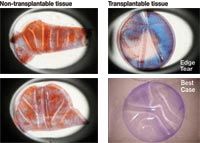Article
Lab study of graft preparation outcomes raises concerns
Although Descemet's membrane endothelial keratoplasty represents the ideal of pure anatomic replacement surgery, results of a laboratory study indicate the procedure is still in an early stage of development.
Portland, OR-Although Descemet's membrane endothelial keratoplasty (DMEK) represents the ideal of pure anatomic replacement surgery, results of a laboratory study indicate the procedure still is in an early stage of development and not yet ready for prime time, said Mark A. Terry, MD.

"The practical consideration with DMEK is that in harvesting the tissue, 'if you break it, you buy it,' " said Dr. Terry, who also is professor of clinical ophthalmology, Oregon Health & Science University, Portland. "If the graft tissue is destroyed in the operating room when it is being stripped from the posterior capsule, there is a monetary loss of about $2,500 to the surgeon and ambulatory surgery center.
To investigate tissue wastage during graft harvesting for DMEK, Dr. Terry and a DMEK course-trained technician performed donor Descemet's stripping to prepare 8-mm diameter DMEK discs from donor corneas.
They used the same SCUBA technique, which is the method currently taught in DMEK courses, although Dr. Terry had more prior experience than the technician.
The donor tissues were evaluated for the presence of edge tears and whether they were totally destroyed (not transplantable). In addition, the extent of donor endothelial cell loss was assessed quantitatively by two methods: digital photographic analysis of damaged cells stained with vital dyes and of healthy cells identified by calcein AM fluorescent dye staining.
"In stripping the donor, the tissue may tear right through the middle and then it has to be discarded," Dr. Terry said. "The best-case scenario is if the tissue is completely intact, but sometimes there are edge tears and the disc can still be used."
Tissue damage, wastage rates

"These results show that the currently taught method of DMEK donor harvesting has unacceptably high tissue damage and wastage rates, and the fact that the technician's performance was worse than the surgeon indicates there exists a limitation for using precut tissue," Dr. Terry said. "Further work needs to be done in the laboratory to create an easier and safer method of donor harvesting prior to general use of DMEK, and surgeons who are considering performing this surgery should have extensive experience in harvesting DMEK donor tissue prior to attempting clinical practice."
For all 23 DMEK discs, the endothelial damage rate was 18%, with rates for the discs prepared by the technician and surgeon being 22% and 17%, respectively.
"Tissue manipulation and endothelial damage are more likely with graft preparation for DMEK than with DSAEK, and there are no long-term endothelial survival data available for DMEK," Dr. Terry said. "Use of a trephine to harvest the lenticule for DSAEK leads to an endothelial cell loss rate of about 9%, and in our eye bank, the tissue wastage rate for DSAEK grafts is under 1%."
Dr. Terry also compared clinical outcomes of DSAEK with those of DMEK reported by Gerritt Melles, MD, PhD, Rotterdam, The Netherlands. Dr. Melles first described DMEK, performed the first clinical case, and recently analyzed results of his first 50 consecutive cases.
In Dr. Melles' hands, the primary graft failure rate was 20% and the dislocation rate was 25%. Dr. Terry reported that in a series of 550 consecutive DSAEK cases at Devers Eye Institute by five different surgeons, the primary graft failure rate was <1% (a single case out of 550 cases) and the dislocation rate was 1.8% (10 of 550 cases).
"Dislocation and graft failure rates with DMEK are even higher in unpublished series from other surgeons," he concluded. "Research in DMEK should be pursued. Right now, however, the procedure has too high a complication rate to be utilized on a widespread basis."
Newsletter
Don’t miss out—get Ophthalmology Times updates on the latest clinical advancements and expert interviews, straight to your inbox.





